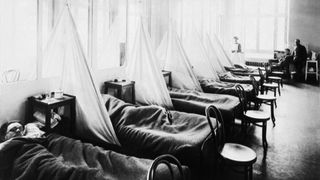Skeletons from 1918 flu dispel myth that young, healthy adults were more vulnerable to the virus
Frail people and those with preexisting conditions were most likely to die from the 1918 flu — not young, healthy adults as once believed, a study of the victims' skeletons suggests.

The 1918 flu was one of the deadliest pandemics in history, killing at least 50 million people worldwide. It was long believed that young, healthy adults were just as likely to die from the illness as those who were older, sick or frail — but a new study has turned this idea on its head.
Scientists examined skeletons of people who died before and during the 1918 pandemic. Signs of stress in the bones suggest that, regardless of their ages, people who were already frail or unhealthy were more likely to die during the crisis than those who weren't.
The findings, published Monday (Oct. 9) in the journal PNAS, are perhaps not surprising, but they're a reminder of how individuals' attributes can shape their susceptibility to disease, the authors said.
"Even in a novel pandemic — one to which no one is supposed to have prior immunity — certain people are at a greater risk of getting sick and dying, and this is often shaped by culture," Amanda Wissler, lead author of the study and an assistant professor of anthropology at McMaster University in Ontario, told Live Science in an email. In other words, people who are already disadvantaged in terms of their health or socioeconomic status tend to be more vulnerable to outbreaks, she said.
Related: 1918 flu mutated to become deadlier in later waves, century-old lungs reveal
The 1918 flu spread so fast that doctors originally believed that healthy young adults were as likely to die as older people who were already frail and babies with immature immune systems. The pattern of flu deaths across age groups was "W-shaped," with peaks at very young and very old ages, and another peak among young adults. Most flu outbreaks have "U-shaped" death curves, with peaks on both ends of the age spectrum.
The W-shaped curve highlighted an unusual trend among young people, but it didn't take their preexisting conditions into account. Evidence of rampant death among healthy young adults was mainly anecdotal and had no concrete scientific backing, the study authors wrote in their paper. Historical documents, such as census data and life insurance records, contained scant details on the people's health conditions and socioeconomic pressures.
In the new study, scientists examined the skeletons of 81 people who died when the flu struck Cleveland between September 1918 and March 1919 and those of 288 people who died before the pandemic. They looked at the ages of death and for bumps, or "lesions," on the people's shinbones, which served as markers of physical stress and underlying health conditions. When the body is stressed as a result of physical trauma, infection or nutritional deficiencies, inflammation triggers healing and the formation of new bone.
People who had active shinbone lesions were considered the frailest, and compared with people with healed lesions, they were more likely to die before and during the pandemic. During the pandemic, their risk of death was 2.7 times greater than that of people who had healed lesions.
Young people were not an exception to this trend. Regardless of their age of death, those who had evidence of stress in their bones were more likely to have died from the flu than those who started out healthier.
The study had several limitations: It only included skeletons from Cleveland, meaning the results can't necessarily be applied to other places. And the shinbone technique is great for looking at general patterns of frailty but can't explain the exact causes of the lesions. Nevertheless, the findings may reflect how health and social disparities tend to drive death rates in pandemics — similar to trends seen in the COVID-19 pandemic, or even the Black Death.
"We saw during COVID-19 that people who were socially and economically minoritized had a greater risk of getting sick and dying, and I suspect a similar thing happened in the 1918 flu," Wissler told Live Science.
The misconception that healthy adults were equally likely to die during the 1918 pandemic as frailer people may reflect the fact that young adults, in general, were at greater risk in the 1918 flu than in previous outbreaks, the authors wrote in the paper. Scientists have since proposed theories for this — perhaps a virus similar to the pandemic flu circulated before those young adults were born, leaving them especially susceptible once the 1918 virus emerged.
It would have been surprising to see lots of young people dying, which probably made the trend stand out, the authors concluded.
Live Science newsletter
Stay up to date on the latest science news by signing up for our Essentials newsletter.

Emily is a health news writer based in London, United Kingdom. She holds a bachelor's degree in biology from Durham University and a master's degree in clinical and therapeutic neuroscience from Oxford University. She has worked in science communication, medical writing and as a local news reporter while undertaking journalism training. In 2018, she was named one of MHP Communications' 30 journalists to watch under 30. (emily.cooke@futurenet.com)
Most Popular

By Harry Baker

By Sascha Pare